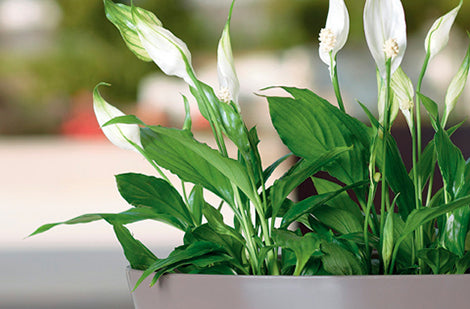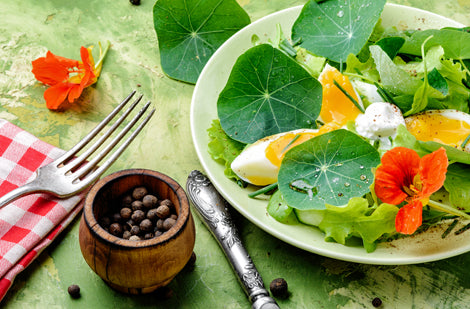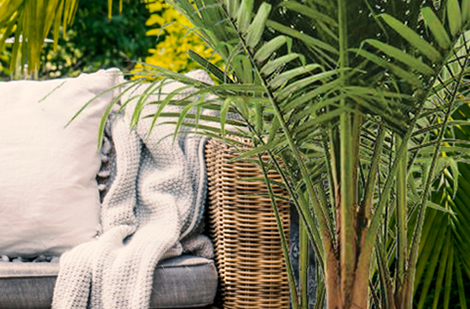Calathea 'Zebrina'
Calathea 'Zebrina' (Zebra Plant)
Calathea 'Zebrina' (Zebra Plant)
Exposure
- Bright Indirect Light
Rusticity
- Unique striped foliage
- Folds leaves at night
- Attractive tropical plant
- Requires high humidity
- Beautiful indoor plant
The Calathea 'Zebrina' is a tropical indoor plant famous for its uniquely striped foliage, giving rise to the common name Zebra Plant. Similar to its popular cousin—the prayer plant—Zebra Plant leaves are bright green with dark green stripes. Foliage colour isn’t the only thing these tropical houseplants have in common, as both plants are known to raise or fold their leaves at night. Calathea 'Zebrina' grows up to 90 cm (3 feet) tall, with leaves reaching up to 60 cm (2 feet) long.
Key Features
- Foliage: Large oval leaves of bright green, adorned with distinctive dark green stripes reminiscent of a zebra's coat. The underside of the leaves is often a purple colour. Interestingly, the leaves have the characteristic of rising and folding vertically at night, a phenomenon called nyctinasty.
- Habit: Grows upright and bushy, forming a beautiful clump of decorative foliage.
- Growth: Considered moderate, the plant may take a few years to reach its mature size indoors.
- Care: Classified as moderate to difficult due to its specific needs for humidity and watering. Consistent attention is required to maintain its optimal appearance.
- Flowering: Flowering is rare as an indoor plant. If it does bloom, it is usually in the spring, producing small purple or white flowers that emerge on spikes. However, it is primarily cultivated for its spectacular foliage.
Care Tips
- Light: Prefers bright, indirect light. Avoid direct sunlight, which can burn the leaves.
- Soil: Requires loamy, moist but well-drained soil. A mix of potting soil, perlite, and peat moss is ideal.
- Watering: Water regularly when the top inch or two of the soil begins to dry. Generally once a week during the growing season and less often in winter.
- Temperature and Humidity: Requires high humidity, ideally above 60%. Warm temperatures between 18°C and 24°C (65°F and 75°F) are preferred. Avoid temperatures below 10°C (50°F). A humidifier, a tray of pebbles with water, or regular misting can help maintain humidity.
- Fertilization: Fertilizing is generally not necessary. If growth is slow, fertilize lightly during the growing season with a balanced formula diluted to a quarter of the recommended strength.
- Propagation: Can be propagated by division in the spring when the plant has produced several rosettes of leaves at the base.
- Repotting: Repot every two years or so, when the plant becomes root-bound. Choose a slightly larger pot with good drainage holes.
Common Problems
- Brown, Curling Leaf Tips: Indicates a lack of humidity or water. Increase humidity and water if the soil is dry.
- Drooping, Mushy Stems: Sign of overwatering. Act quickly to prevent root rot.
Plant details
Dimensions
Dimensions
Characteristics
Characteristics
Habit:
- Upright
- Bushy
Flowering colours:
Plant needs
Plant needs
Watering:
- Tolerates moist soil
Maintenance:
- Average
Soil requirement:
Features
Features
Resistance:
Attract:
Use:
Attribute:
- Slow growth


Related articles
-

Potting House Plants: which pot to choose
Read the articleBien qu'une plante puisse passer plusieurs mois et parfois même plusieurs années dans le même pot, avec le temps ses racines envahissent tout l'espace disponible. Il devient important de choisir...
-

Moving Up a Level: Advanced Guide to Repotting ...
Read the articlePropagate your violets! Discover the simple cutting method, the secret to the perfect soil mix, and how to fight mealybugs.
-

The Complete Guide to Buying and Caring for Ind...
Read the articleBringing a touch of nature to your home with plants is a great idea! Not only do they beautify your living space, but they also help purify the air. However,...
-

Build Your Own Terrarium: The Complete, Easy Gu...
Read the articleThe terrarium is the perfect addition to your decor! Learn how to easily create your own miniature garden with our complete guide.
-

Create a garden with succulents
Read the articleLes plantes grasses n’ont pas leur pareil pour créer des arrangements à la fois impressionnants par leurs couleurs, leurs formes et leurs textures et faciles à entretenir. Qu’on les agence...
-

Houseplants to discover - Butterfly Palm or Are...
Read the articleDypsis lutescens, anciennement Chrysalidocarpus lutescens
-

Calathea: The Essential Guide to Mastering the ...
Read the articleCalathea is a stunning addition, but it's demanding! The key to its success? Humidity. Find out why tap water and dry air are its worst enemies and how to give...
-

Jade Plant (Crassula): The Easy-Care Succulent ...
Read the articleThe jade plant is a must-have! Learn all the secrets to caring for this resilient succulent that naturally grows into an elegant miniature tree.
-

Madagascar Dragon Tree: Embrace Effortless, Gra...
Read the articleAdd a modern touch to your home! The Madagascar Dragon Tree is low-maintenance, perfect for beginners, and stands out with its slender look and two-toned foliage.
-

Aspidistra: The "Cast Iron Plant" Indestructibl...
Read the articleDon't have a green thumb? The Cast Iron Plant is for you! Tolerant of shade and missed waterings, it's perfect for lobbies and offices. Learn how to maintain its leathery...
-

Embrace the Fern: The Champion of Shade and Tro...
Read the articleGot a dark corner? Ferns are your allies! They are easy to care for if you master one factor: humidity. Learn how to water them perfectly for spectacular and full...
-

-

Kalanchoe: The Secret to Massive Blooms That La...
Read the articleNeed lasting colour? The Kalanchoe blooms profusely for over two months! An easy succulent that tolerates neglect and adds a vibrant touch to your home.
-

Snake Plant: The Unkillable Houseplant, Perfect...
Read the articleThe Snake Plant is an ideal houseplant for everyone, whether you're a beginner or an experienced gardener. Its resilience, ease of maintenance, and decorative appearance make it an essential choice...
-

Edible Flowers: Top 5 for Garden and Kitchen
Read the articleOffrant une belle gamme de couleurs, de formes et de textures, les fleurs comestibles enthousiasment les amoureux de jardinage et de cuisine.
-

Tropical Flowering Plants: A touch of the exoti...
Read the articleLes plantes tropicales à fleurs ont tout pour faire tourner les têtes! Colorées, odorantes, généreuses, elles n’ont pas leur pareil pour égayer une aide de repos, un balcon, une terrasse....
-

Keep a palm tree on the terrace - why not!
Read the articleDifficile de résister à l’appel des tropiques quand le soleil et les températures clémentes se pointent le bout du nez. Rien de mieux qu’un palmier sur la terrasse ou le...
-

Bring Your Plants Indoors for Winter: The Compl...
Read the articleDon't get caught by the first frost! Prepare your outdoor plants for winter with our complete guide.
-

When and how to repot house plants
Read the articleAlthough a plant can spend several months and sometimes even several years in the same pot, over time its roots invade all the available space.
-

How to select the best houseplant potting soil
Read the articleIl est important d'adapter le substrat utilisé au type de plante. Plusieurs mélanges sont possibles à partir de terre brune, de mousse de tourbe, de perlite ou de vermiculite. Pour...



























